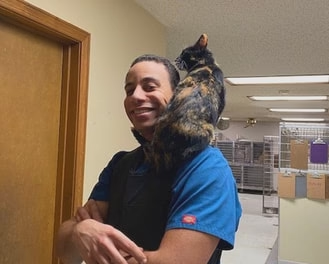7 Min Read
Pet Adoptions Statistics: Facts & FAQs
Key takeaway
Adopting a pet can help reduce strain on shelters and give pets in shelters a safe, comfortable home. Every year, millions of pets are taken in by shelters, and many shelters have a difficult time providing for all of those animals. If you want to get a great dog and help out a shelter, adopting a dog is a great route to go.

Why pet owners are switching to online vet care with Dutch
-
Prescriptions delivered free to you
-
Fast access to Licensed Vets over video
-
Unlimited video visits and follow-ups
Every day, shelters all over the country take in pets who need a good home, but finding a good home for them isn’t always easy. According to statistics on pet adoption, more than 6 million pets are accepted into shelters every year.1
Adopting a pet is a great way to find a loyal companion while also helping animals in shelters find a home. Plus, it helps shelters avoid overcrowding, in turn, reducing the risk of kennel cough and other contagious diseases. While many pet parents want a trained puppy or have a specific breed they’re interested in, adopting a pet is your way to give back to the animals that help you live a happy life.
Want to learn more statistics about pet adoption? In this article, we’ll talk about important statistics about adopting pets and the benefits of adoption. If you’re thinking about adopting, here’s everything you need to know first.
- US Shelter Statistics
- Adopting vs. Buying
- Pet Adoption Statistics: FAQs
- Reasons to Consider Adoption
- Final Notes
US Shelter Statistics
According to pet adoption statistics, animal shelters in the United States take in about 6.3 million animals each year. Despite millions of animals entering U.S. shelters every year, there are only about 14,000 animal shelters and animal rescue groups across the country. This massive influx of animals puts a lot of pressure on shelters, and it’s the reason shelters are so strapped for resources.
Despite all the work that shelters put in to rehome animals, only about 4.1 million of the 6.3 million animals in shelters find a home each year. This makes things even more difficult for shelters because they may have to take care of pets for a long time before finding them a home. If you’ve been wanting a dog or cat, adopting from a shelter is a good way to help improve pet adoption statistics and bring home a furry friend to love.
Some of the dog breeds that are most commonly found in shelters include:
- Pit Bull Terriers
- Labrador Retrievers
- German Shepherds
- Dachshunds
- Chihuahuas
- Boxers
While many people avoid shelters because they want a purebred dog who’s been through dog obedience training, up to 25% of dogs in shelters are actually purebred. And as long as you’re adopting your puppy at a young age, you have plenty of time to train them and teach them how to be model canine citizens.
There are also lots of cats in shelters who need a home. In fact, between 50% and 75% of the shelter population in the United States is cats. As far as shelter cats go, black cats are the least likely to be adopted. The good news is, 43% of cat parents found their furry friend at a shelter or rescue facility, so there are many people working to help find a home for cats.2
From 2016 to 2022, the percentage of no-kill shelters has doubled from 24% to 48%. While this is good news, there’s still a long way to go when it comes to finding a home for every animal. If you want to help reduce the number of animals in shelters and find a great pet, adopting is a great route.

Adopting Vs. Buying
If you want a specific breed or want to know just how big your puppy will be when they’re fully grown, buying a dog can be tempting. Getting a pet from a breeder allows you to choose which breed you want, when you want to adopt your puppy or kitten, and more.
While buying can be tempting, adopting a pet can be better for several reasons. First, up to 25% of dogs in shelters are purebred, so you’re not necessarily sacrificing anything in terms of breed. Adopting also saves you money, so you don’t have to spend thousands to get the dog breed you want. You also get the satisfaction of knowing you saved a life, giving a puppy or kitten who desperately needs it a safe home. However, some adopted pets may have problems with resource guarding as a result of being around so many other animals, although bred dogs may also face the same challenges.
Ultimately, it’s your decision whether you buy or adopt, but adopting a pet is a good way to keep them out of shelters and lower pet adoption statistics.
Pet Adoption Statistics: FAQs
Want to know more statistics on pet adoption? Get the answers you need to some of the most-asked pet adoption questions below.
How Many Pets Are Adopted Each Year in the US?
According to pet adoption statistics, there are about 4.1 million pets who are adopted every year, compared to a total of 6.3 million pets who enter shelters and rescue facilities each year. Of the 4.1 million pets adopted, about 2.1 million are cats and 2 million are dogs.
Because more pets enter shelters than are adopted each year, you can make a big difference by adopting your next pet.
Which State Has the Highest Pet Adoption Rate?
Statistics indicate that the states that have the most pet adoptions are, in order3:
- California
- Texas
- Florida
- Colorado
- Arizona
- North Carolina
- Washington
If you’re not in one of these states, adopting a pet can make an even bigger difference. Some states have significantly lower pet adoption rates, which means their shelters fill up faster.
What Is the Least Adopted Dog?
The American Staffordshire terrier is the least likely breed to be adopted because of their size, followed by the Pit Bull terrier. These breeds are even less likely to be adopted if they’re not babies, so rehoming them as adults can be very difficult. Adopting breeds that aren’t commonly adopted is one of the best things you can do as a pet parent.2
What Is the Least Adopted Cat?
Black cats are generally the least likely to be adopted, especially very large black cats who are older. People tend to adopt younger cats and kittens who are gray, tabby, orange, or brown. The good news is, millions of cats are adopted each year, so even black cats are still fairly likely to be adopted according to adoption statistics.2
What Percentage of Dogs Are Adopted Vs. Bought?
According to the ASPCA, about 34% of dogs are purchased from breeders, while 23% or so are adopted from a shelter. Another 20% of dogs come from family and friends, while about 6% are taken in off the street as strays. Even if you can only adopt a single dog, you can make a big difference for your local shelter.4
Reasons to Consider Adoption
There are a lot of reasons to consider adopting a dog or cat, especially if you’re not looking for one particular breed. Not only do you get a furry friend to add to your family, but you’re also saving a life and helping out your local shelter. Without people to adopt them, hundreds of thousands of pets in shelters are euthanized each year.
If your local animal rescue shelter has a problem with overcrowding, adopting a cat or dog can help them provide a better environment for sheltered pets. Taking care of your adopted pet is easier with telemedicine for pets, and you can even train your adopted dog or cat if you have the patience. If you want to help out your local shelter and form a bond between pet and owner that can’t be broken, adopting a pet is a great way to go.

Final Notes
Every year, millions of pets are taken in by shelters and animal rescue facilities, but only some of those animals find a permanent home. Adopting a dog or cat is a great way to help out your local shelter and save a life, and it doesn’t cost as much as buying a purebred dog for thousands of dollars.
If you’re thinking about adopting, you can always talk with an expert first. With Dutch, you can schedule a video chat with a vet to get expert advice from the comfort of your living room. Try Dutch today to learn more about pet adoption statistics and get expert advice to help you find the perfect pet.
Share
References
-
“Pet Statistics.” ASPCA, https://www.aspca.org/helping-people-pets/shelter-intake-and-surrender/pet-statistics#:~:text=Approximately%204.1%20million%20shelter%20animals,are%20returned%20to%20their%20owners.
-
“What Kinds of Pets Get Adopted?” Priceonomics, 20 Mar. 2022, https://priceonomics.com/what-kinds-of-pets-get-adopted/#:~:text=Black%20and%20white%20cats%2C%20also,500%20times%20in%20the%20dataset.
-
Velez, Lily. “Pet Adoption Statistics by State: Honest Paws®.” Honest Paws, 22 Oct. 2021, https://www.honestpaws.com/blog/pet-adoption-statistics-by-state/#:~:text=First%2C%20we%20looked%20at%20the,and%20203%2C385%20pet%20adoptions%20respectively.
-
Written by Nicole Cosgrove Lead Pet Expert & Pet-ditor in Chief Nicole is the proud mom of Baby, et al. “17 Pet Adoption Statistics & Facts to Know in 2022.” Pet Keen, 6 May 2022, https://petkeen.com/pet-adoption-statistics/#:~:text=Around%2034%25%20of%20dogs%20that,are%20taken%20in%20as%20strays.



